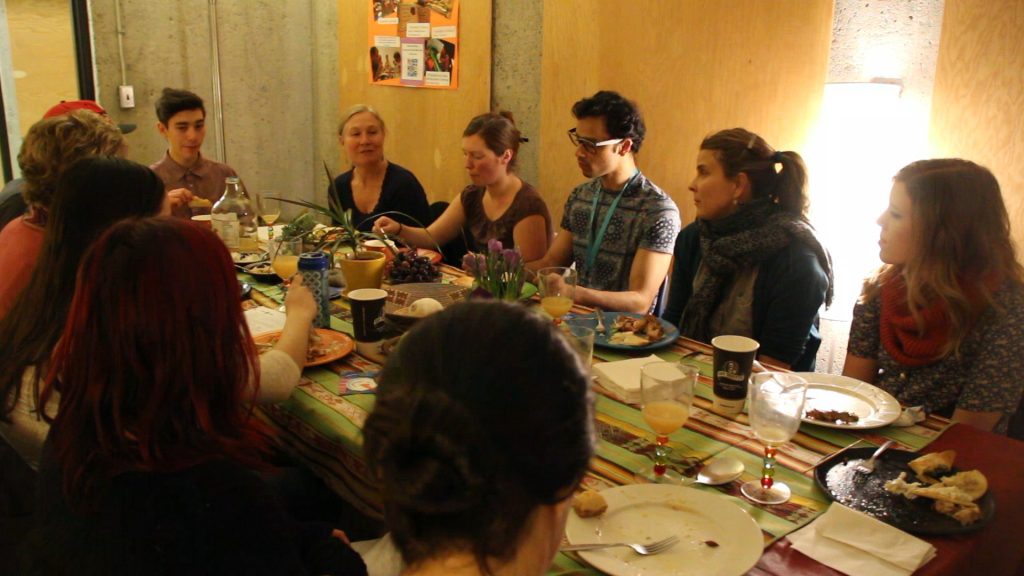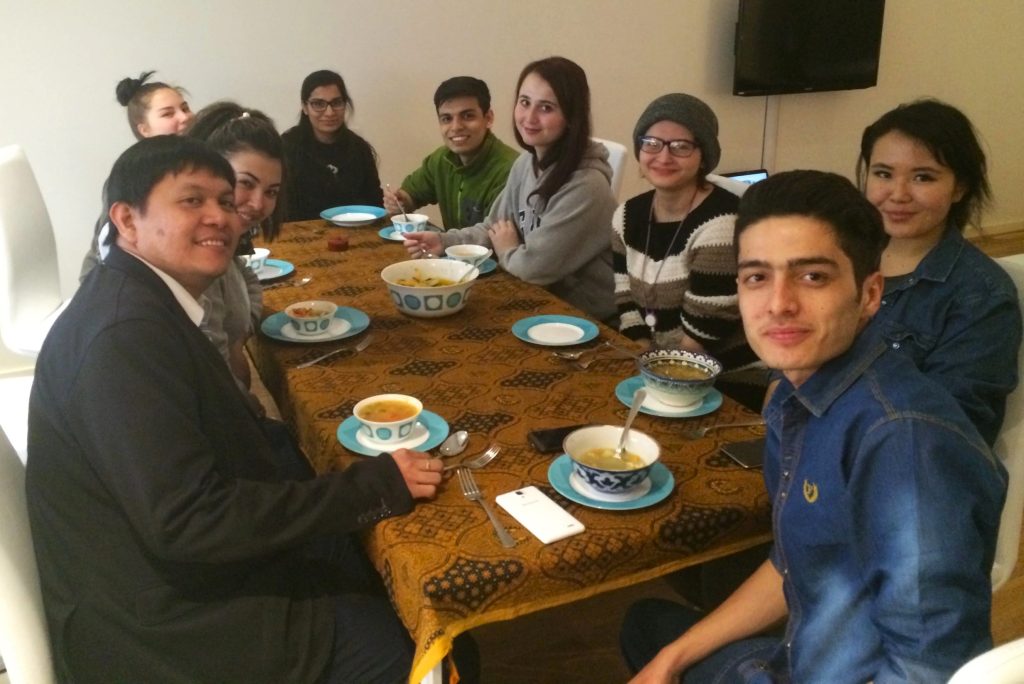32 Dinner Basket Conversations
Food brings people together

“Good food + Good Conversation means a healthy culture.”
–Selkirk College Student at a Dinner Basket Conversation
Purpose:
This activity helps build community through cooking, eating and conversation. It is becoming less common for people to sit down for meals together, but there is increasing evidence cooking and eating together is an important way people can relax, talk and bond.
Learning Objectives
Participants will:
- Enhance life skills as they help each other to cook a meal together.
- Create a warm environment by setting the table.
- Discuss a meaningful topic.
- Reflect on the experience of cooking, eating and sharing conversation together.
Description of the Dinner Basket Process when used by Selkirk College, British Columbia, Canada, as part of the provincial “Changing Cultures of Substance Use” project. Although these dinner basket conversations focussed on substance use, the topics can be suited to the needs of the participants.
What Are Dinner Basket Conversations?
Dinner Basket Conversations (DBC) are a means by which groups of people can gather together to create and eat a meal, while engaging in conversation around a chosen topic. Evidence suggests that more ease and flow is created in conversation when it is held in the context
of sharing a meal. The purpose is to gather information about the “culture of substance use” and peripherally influence cultural shifts. In the case of this study, the Dinner Basket Conversations that the stories were gleaned from focused on substance use and relationships with substances.
Facilitators volunteer to host a DBC. They invite a group of people whom they would like to engage in the conversation and purchase the groceries for a meal, usually provided by the coordinator of the DBC project. Facilitators are given a suggested list of conversation starters. They are encouraged to make notes on the themes and discussions that arise and, with permission from the participants, take pictures of the event. An evaluation of the event is handed out to the participants after it is over and these evaluations are collected and given to the coordinator.
by Leslie Comrie, M.A., Healthy Campus Coordinator, Selkirk College, B.C. Canada
This project was supported and researched by the provincial Healthy Minds|Healthy Campus organization.
This is an excerpt from a research project conducted looking at the impacts of dinner basket conversations on both participants and facilitators.
Most-Significant-Change-Stories-for-Dinner-Basket-Conversation-Facilitators.pdf

Activity Directions
- Promotion: The orgnization that is promoting dinner basket conversations will need to do some promotion about the project and probably the first few dinners could be hosted and facilitated by staff or community leaders.
- Invitation: Send an dinner invitation to a group of 6 – 10 people. The invitation should be explicit about the fact that everyone will be cooking and eating together and discussing a particular topic.
- Questions: Generate 4 – 6 questions on the chosen topic for the group to address while they are having their meal.
- Organize food: Choose recipes, budget and create shopping list.
- Buy ingredients: The facilitator might do the shopping for this activity or take some of the participants to the supermarket in which case the shopping for healthy ingredients and staying within the budget can be part of the learning experience. It is also possible to do this activity without a designated facilitator where the group agrees to share in the responsibilities of shopping, cooking, facilitating conversations and cleaning up. Some organizations have a budget that allows people to do their own shopping or the participants send a coordinator the chosen recipes and a shopping list and then the coordinator delivers the basket to the location the dinner party is being hosted.
- Meet, greet and discuss process: Invited group meets together in a kitchen. First, everyone sits down and reads over the recipes for the meal and people choose cooking tasks. It is good to have several cutting boards and knives for different food prep stations.
- Set Table: As the food is getting close to being ready, some participants can set the table. It helps to create ambience if there is a table cloth, and possibly flowers and candle light. The idea is to create a cosy atmosphere where people can savour their meal and share ideas together.
- Facilitated Conversation: As people eat, the hosts facilitate a conversation focussed on the designated topic. As with all facilitated conversations, try to include all voices and summarize themes.
- Reflections and feedback: At the end of the meal, ask for oral feedback on people’s experience of cooking, eating and talking together. Ask them to fill out a reflection sheet about their experiences and insights about both the meal and the conversation topic.
- Clean-Up: Continue the conversations as you all clean up together.

Sample Reflection Questions for feedback forms:
- What was it like for you to participate in this evening’s Dinner Basket Conversation?
- What are you taking away from this discussion?
- Tonight we were discussing _______________. Do you have any insights or suggestions to others about this topic?
- Do you have any suggestions for improving the Dinner Basket Conversation project?
- Any other feedback for us about your experience of this event?
Sample of feedback statements from Dinner Basket Conversations:
“I really enjoyed participating in the Dinner Basket Conversation evening. I particularly like how inclusive the meal sharing and conversation felt. It was obvious that everyone sharing and listening respected personal insight and valued the learning from other’s experiences. The social responsibility aspect of the conversation was positive; there is plenty of greatness in our community! Having multiple backgrounds and perspectives made the evening fly by.
“I enjoyed getting together with community members around an enjoyable meal to explore a very real phenomenon that we have all experienced. We will continue to have these conversations with our children and colleagues.”
“Conversation is always easier over a good meal”
“There were a few things that struck me and made me reflect about the lunch basket conversation that I was involved in. After doing some literature review regarding history of community, food as a social aid, substance use in the young adult population, and resiliency and coping mechanisms, the lunch conversation brought all those concepts into action and has allowed me to have a broader perspective of how sharing of experiences of substance use, creating positive social groups, and creating food together can allow individuals a sense of belonging and promote community health.” Third Year Nursing Student
“Not only were ideas around substance use shared, but social supports were created. One participant noted that they spoke more to one of their classmates during that dinner, then they had over the past 3 years. Such is the power of creating community over dinner.”
Impact Story from a Dinner Basket Conversation:
During a Dinner Basket Conversation that was attended by a number of young men from a college sports team and a few other students, the following question was asked: “What does a good night of drinking look like and what does a bad night look like?” A quiet young team member, who had not been joining in the general conversation, suddenly looked up and said, “I’ll tell you what a bad night looks like! It’s when something shitty happens to you and you just go out with the aim of drinking as much as you can to forget, and then you find yourself crawling home across the bridge worried that someone is going to mug you!”During this statement a number of his teammates looked visibly impacted and shocked. When he was finished making this statement, there was a short silence and then one teammate said, “Hey man, the next time you feel like that you come and talk to us first. We will make sure that you are kept safe or you can just talk to us about what is going on.” A few of the other teammates chimed in with “yeah, man.” The young man who told the story looked at them and said, “Thanks, man.”
This Dinner Basket Conversation was facilitated by Leslie Comrie, M.A., Healthy Campus Advisor. She wrote this account as part of a research project on the impacts of Dinner Basket Conversations with college students and facilitators.
Most-Significant-Change-Stories-for-Dinner-Basket-Conversation-Facilitators.pdf
Materials and Resources:
- Recipes that work for the budget and nutritional and cultural or religious needs of participants.
- Food to cook the chosen recipes.
- Well stocked kitchen with extra cutting boards and knives so there are tasks for everyone.
- Table big enough for group to sit and eat together or yoga mats and cushions on the floor or outside for picnic style eating.
- Table cloth and possibly flowers and candles.
- Dish soap, scrubbies and dish towels.
- Discussion questions written out either for a facilitator or for all group members to use for self-facilitating. This could include some reminders about respectful conversation where people are listening to understand others and clarifying if they do not understand a perspective.
- Reflection sheets and pens for each participant so they can immediately capture their insights and feedback.
